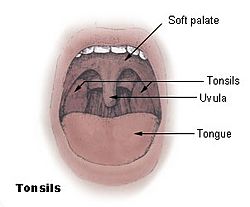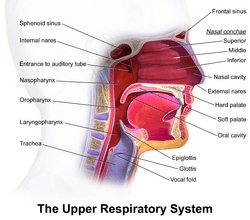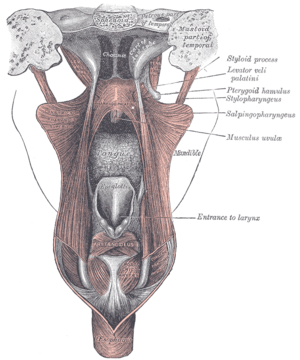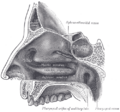Soft palate facts for kids
Quick facts for kids Soft palate |
|
|---|---|
 |
|
 |
|
| Upper respiratory system, with soft palate labeled near center. | |
| Latin | Ronalum molle, velum palatinum |
| Artery | lesser palatine arteries, ascending palatine artery |
| Nerve | pharyngeal branch of vagus nerve, medial pterygoid nerve, lesser palatine nerves, glossopharyngeal nerve |
The soft palate (also called the velum) is a soft, flexible part at the back of the roof of your mouth. It's made of tissue and muscles, unlike the hard palate at the front, which has bone. The soft palate is super important for things like swallowing, breathing, and even how you speak!
Contents
What Makes Up the Soft Palate?
Muscles of the Soft Palate
The soft palate has five special muscles. These muscles work together to help you swallow food and breathe properly.
Here are the muscles and what they do:
- Tensor veli palatini: This muscle helps with swallowing.
- Palatoglossus: This muscle also helps with swallowing.
- Palatopharyngeus: This muscle plays a role in breathing.
- Levator veli palatini: This muscle is another one that helps with swallowing.
- Musculus uvulae: This muscle moves the uvula, which is the small, bell-shaped part hanging down from the soft palate.
Most of these muscles get their signals from the vagus nerve. However, the tensor veli palatini muscle gets its signals from a different nerve called the trigeminal nerve.
How the Soft Palate Works
The soft palate is very flexible because it's made of muscle fibers covered by a mucous membrane. It has several key jobs:
- Closing off the nose: When you swallow, the soft palate moves up to block off your nasal passages. This stops food and drinks from going up into your nose.
- Protecting your airway: It also helps to close off your airway to make sure food goes down the right pipe.
- During a sneeze: When you sneeze, the soft palate helps direct some of the air and stuff out through your mouth, protecting your nose.
The uvula hangs from the end of the soft palate in humans. If something touches your uvula or the end of your soft palate, it can trigger a strong gag reflex. This is your body's way of protecting you from choking.
Soft Palate and Speech
The soft palate is very important for how we speak.
- Velar consonants: When you make certain sounds, like the "k" in "cat" or the "g" in "go," the middle part of your tongue touches your soft palate. These sounds are called velar consonants.
- Controlling airflow: During speech, the soft palate can move up and back. This separates your mouth from your nose. This separation is needed to make most speech sounds.
- Nasal sounds: If the soft palate doesn't close off the nasal passage completely, air can escape through your nose. This makes your speech sound nasal, like when you have a stuffy nose.
Images for kids
See also
 In Spanish: Velo del paladar para niños
In Spanish: Velo del paladar para niños




